Analysis of Chemical Fertilizer Impact on Maize Yields in Kenya
VerifiedAdded on 2023/06/04
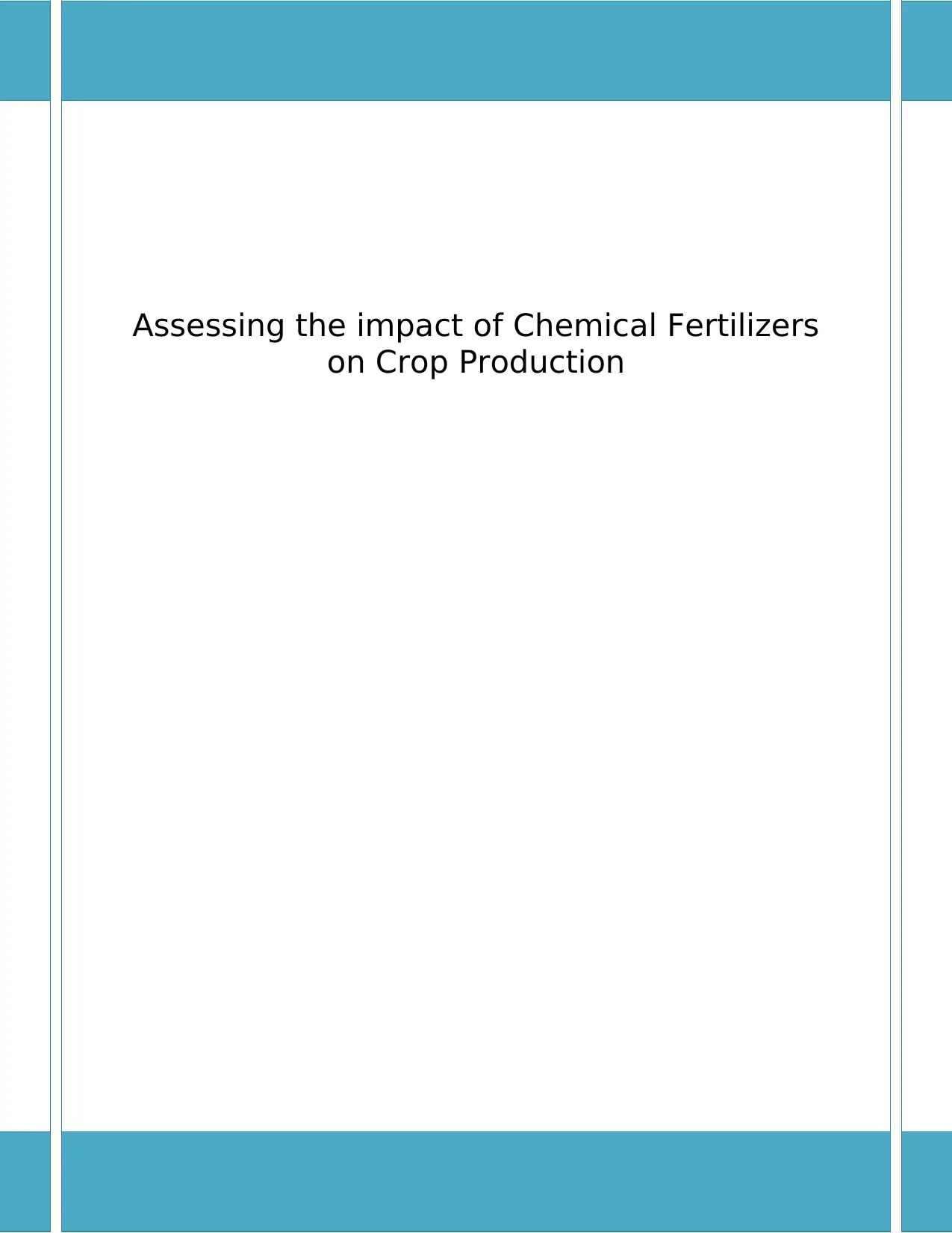
on Crop Production
Paraphrase This Document
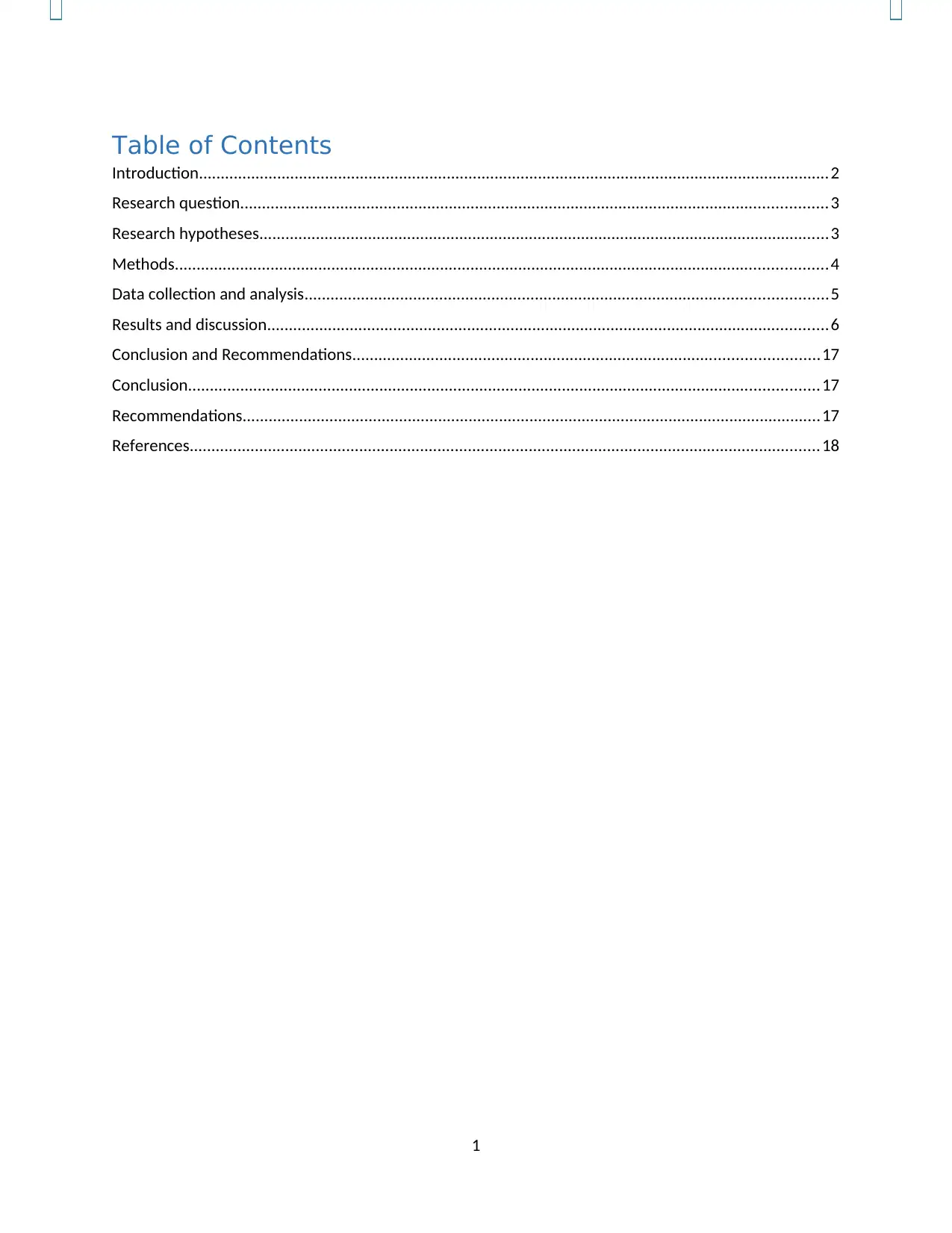
Introduction.................................................................................................................................................2
Research question.......................................................................................................................................3
Research hypotheses...................................................................................................................................3
Methods......................................................................................................................................................4
Data collection and analysis........................................................................................................................5
Results and discussion.................................................................................................................................6
Conclusion and Recommendations...........................................................................................................17
Conclusion.................................................................................................................................................17
Recommendations.....................................................................................................................................17
References.................................................................................................................................................18
1
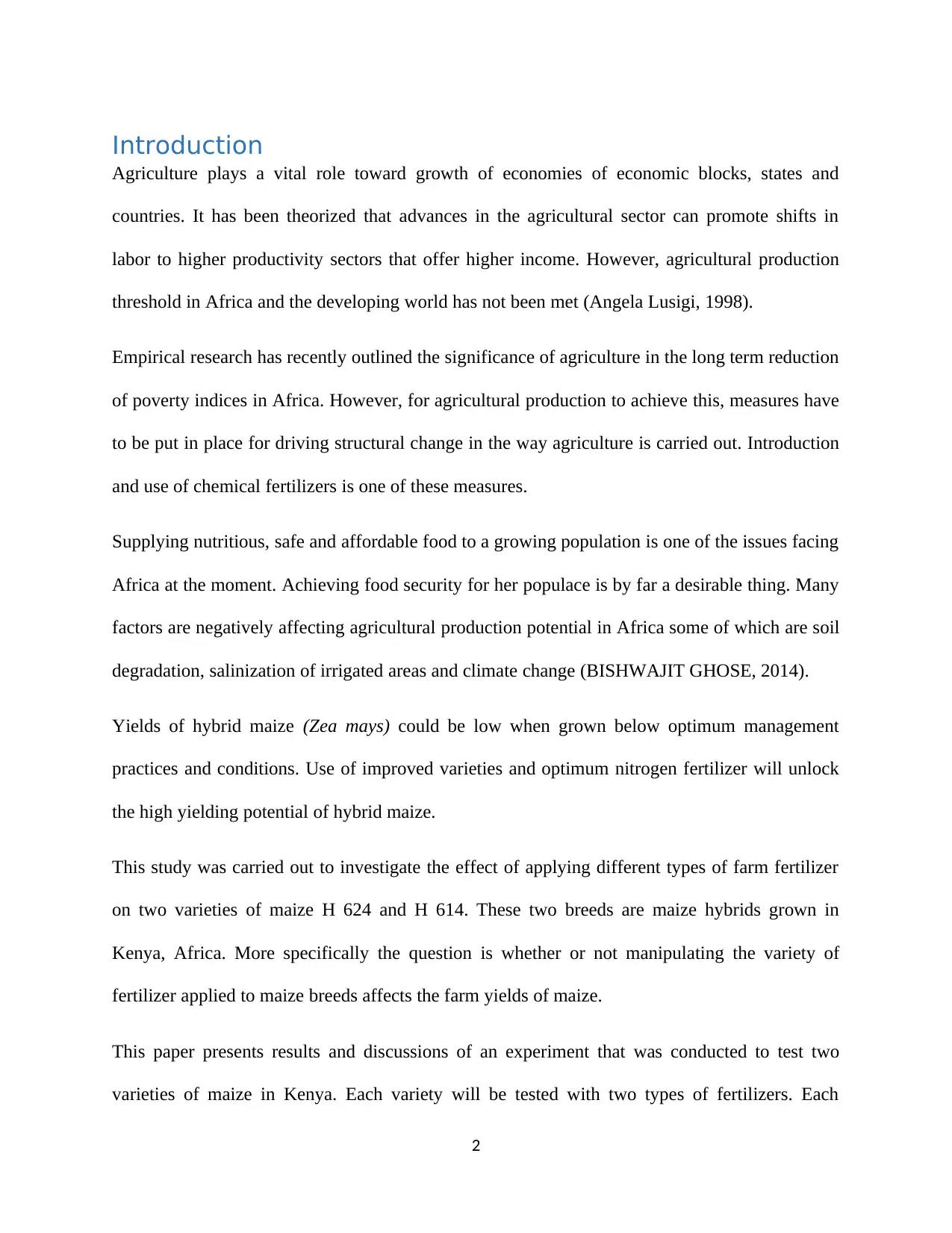
Agriculture plays a vital role toward growth of economies of economic blocks, states and
countries. It has been theorized that advances in the agricultural sector can promote shifts in
labor to higher productivity sectors that offer higher income. However, agricultural production
threshold in Africa and the developing world has not been met (Angela Lusigi, 1998).
Empirical research has recently outlined the significance of agriculture in the long term reduction
of poverty indices in Africa. However, for agricultural production to achieve this, measures have
to be put in place for driving structural change in the way agriculture is carried out. Introduction
and use of chemical fertilizers is one of these measures.
Supplying nutritious, safe and affordable food to a growing population is one of the issues facing
Africa at the moment. Achieving food security for her populace is by far a desirable thing. Many
factors are negatively affecting agricultural production potential in Africa some of which are soil
degradation, salinization of irrigated areas and climate change (BISHWAJIT GHOSE, 2014).
Yields of hybrid maize (Zea mays) could be low when grown below optimum management
practices and conditions. Use of improved varieties and optimum nitrogen fertilizer will unlock
the high yielding potential of hybrid maize.
This study was carried out to investigate the effect of applying different types of farm fertilizer
on two varieties of maize H 624 and H 614. These two breeds are maize hybrids grown in
Kenya, Africa. More specifically the question is whether or not manipulating the variety of
fertilizer applied to maize breeds affects the farm yields of maize.
This paper presents results and discussions of an experiment that was conducted to test two
varieties of maize in Kenya. Each variety will be tested with two types of fertilizers. Each
2
⊘ This is a preview!⊘
Do you want full access?
Subscribe today to unlock all pages.

Trusted by 1+ million students worldwide
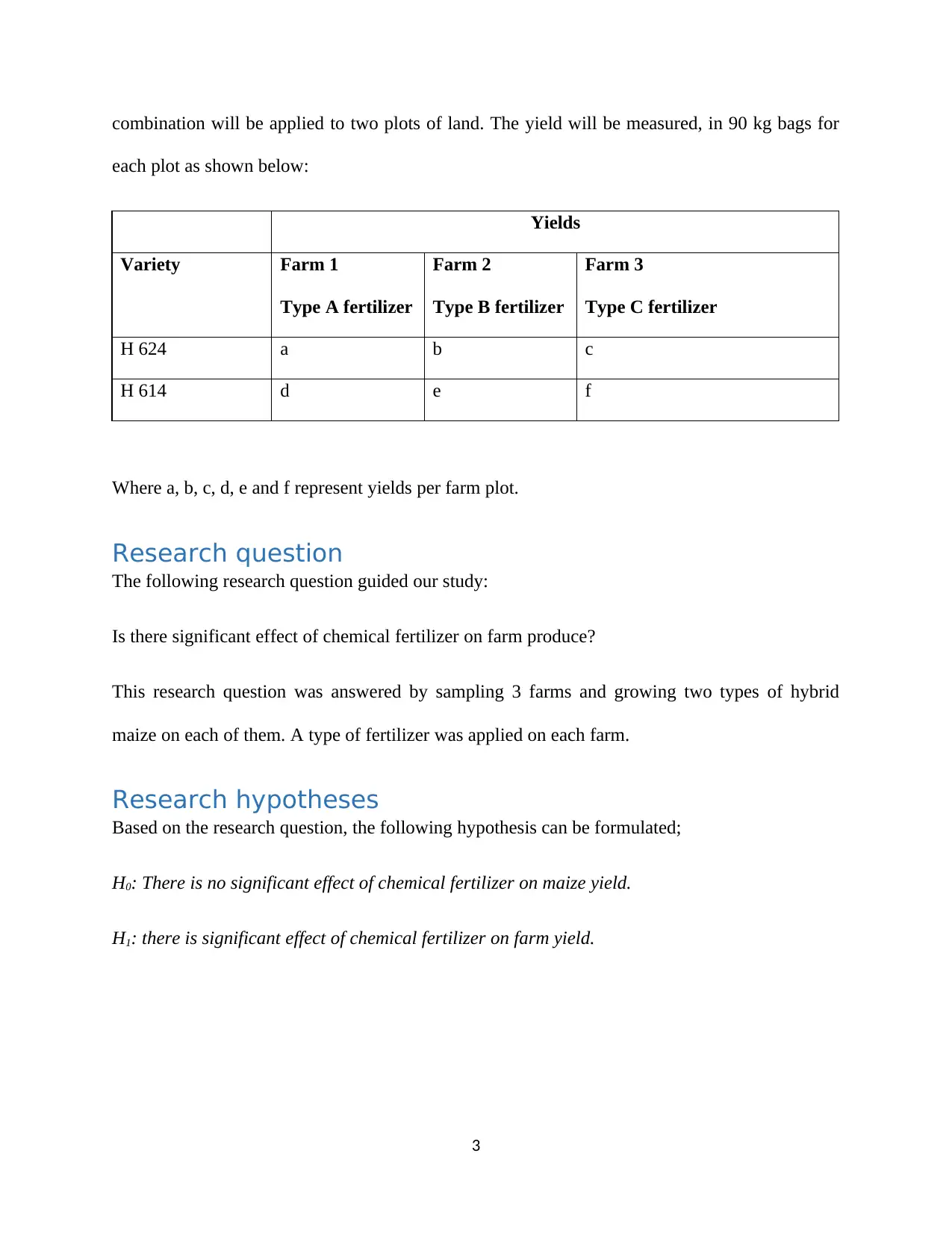
each plot as shown below:
Yields
Variety Farm 1
Type A fertilizer
Farm 2
Type B fertilizer
Farm 3
Type C fertilizer
H 624 a b c
H 614 d e f
Where a, b, c, d, e and f represent yields per farm plot.
Research question
The following research question guided our study:
Is there significant effect of chemical fertilizer on farm produce?
This research question was answered by sampling 3 farms and growing two types of hybrid
maize on each of them. A type of fertilizer was applied on each farm.
Research hypotheses
Based on the research question, the following hypothesis can be formulated;
H0: There is no significant effect of chemical fertilizer on maize yield.
H1: there is significant effect of chemical fertilizer on farm yield.
3
Paraphrase This Document
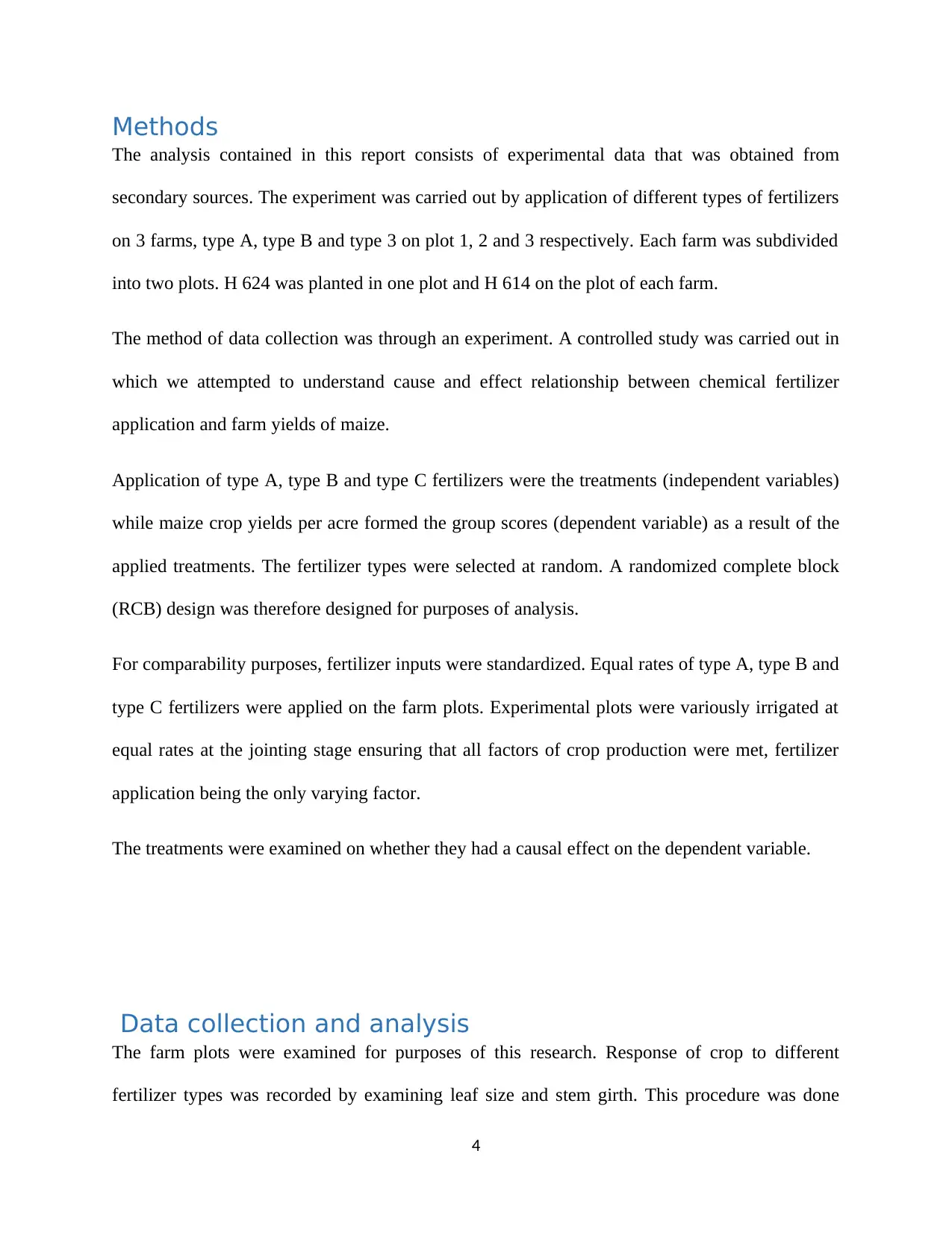
The analysis contained in this report consists of experimental data that was obtained from
secondary sources. The experiment was carried out by application of different types of fertilizers
on 3 farms, type A, type B and type 3 on plot 1, 2 and 3 respectively. Each farm was subdivided
into two plots. H 624 was planted in one plot and H 614 on the plot of each farm.
The method of data collection was through an experiment. A controlled study was carried out in
which we attempted to understand cause and effect relationship between chemical fertilizer
application and farm yields of maize.
Application of type A, type B and type C fertilizers were the treatments (independent variables)
while maize crop yields per acre formed the group scores (dependent variable) as a result of the
applied treatments. The fertilizer types were selected at random. A randomized complete block
(RCB) design was therefore designed for purposes of analysis.
For comparability purposes, fertilizer inputs were standardized. Equal rates of type A, type B and
type C fertilizers were applied on the farm plots. Experimental plots were variously irrigated at
equal rates at the jointing stage ensuring that all factors of crop production were met, fertilizer
application being the only varying factor.
The treatments were examined on whether they had a causal effect on the dependent variable.
Data collection and analysis
The farm plots were examined for purposes of this research. Response of crop to different
fertilizer types was recorded by examining leaf size and stem girth. This procedure was done
4
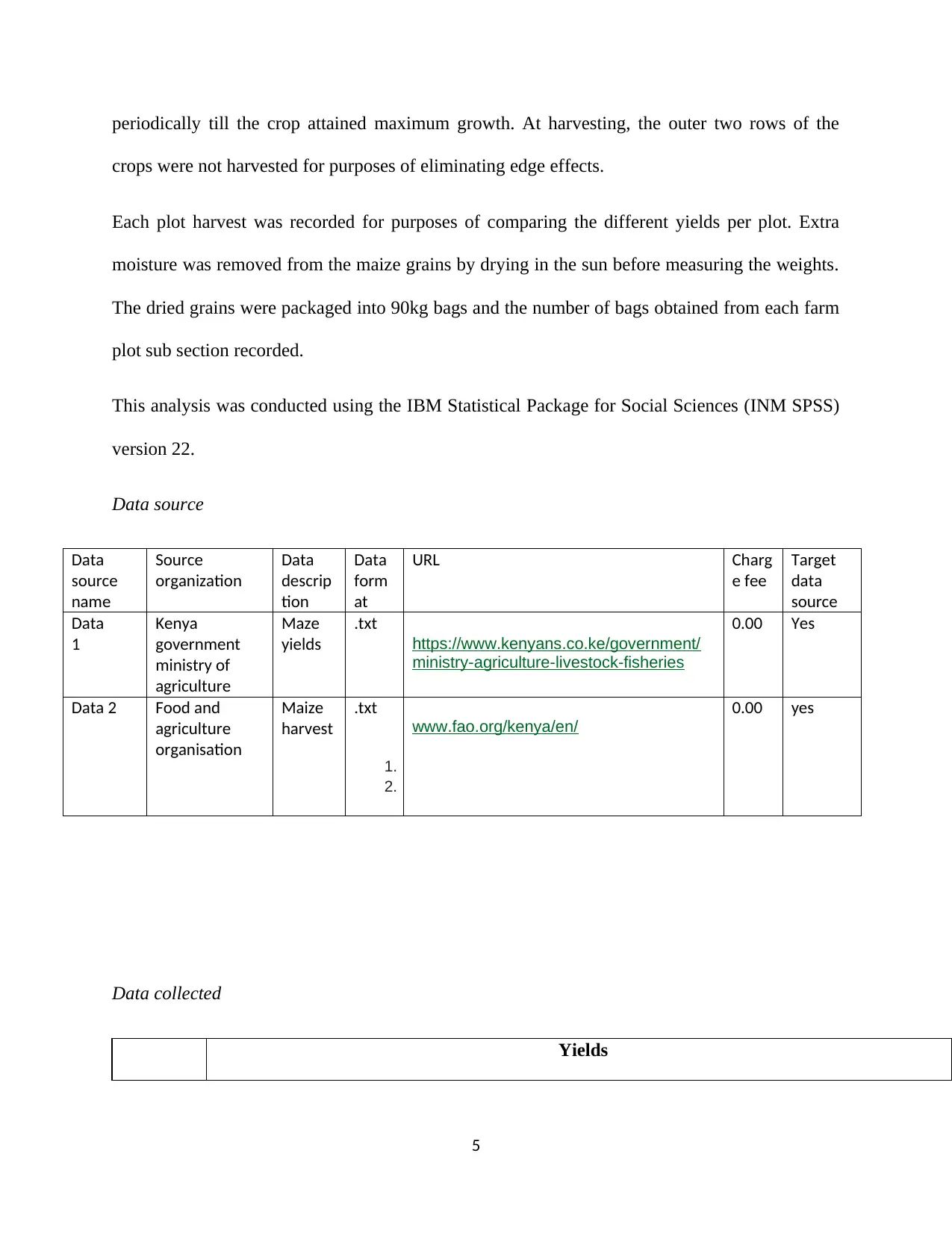
crops were not harvested for purposes of eliminating edge effects.
Each plot harvest was recorded for purposes of comparing the different yields per plot. Extra
moisture was removed from the maize grains by drying in the sun before measuring the weights.
The dried grains were packaged into 90kg bags and the number of bags obtained from each farm
plot sub section recorded.
This analysis was conducted using the IBM Statistical Package for Social Sciences (INM SPSS)
version 22.
Data source
Data
source
name
Source
organization
Data
descrip
tion
Data
form
at
URL Charg
e fee
Target
data
source
Data
1
Kenya
government
ministry of
agriculture
Maze
yields
.txt
https://www.kenyans.co.ke/government/
ministry-agriculture-livestock-fisheries
0.00 Yes
Data 2 Food and
agriculture
organisation
Maize
harvest
.txt
www.fao.org/kenya/en/
1.
2.
0.00 yes
Data collected
Yields
5
⊘ This is a preview!⊘
Do you want full access?
Subscribe today to unlock all pages.

Trusted by 1+ million students worldwide
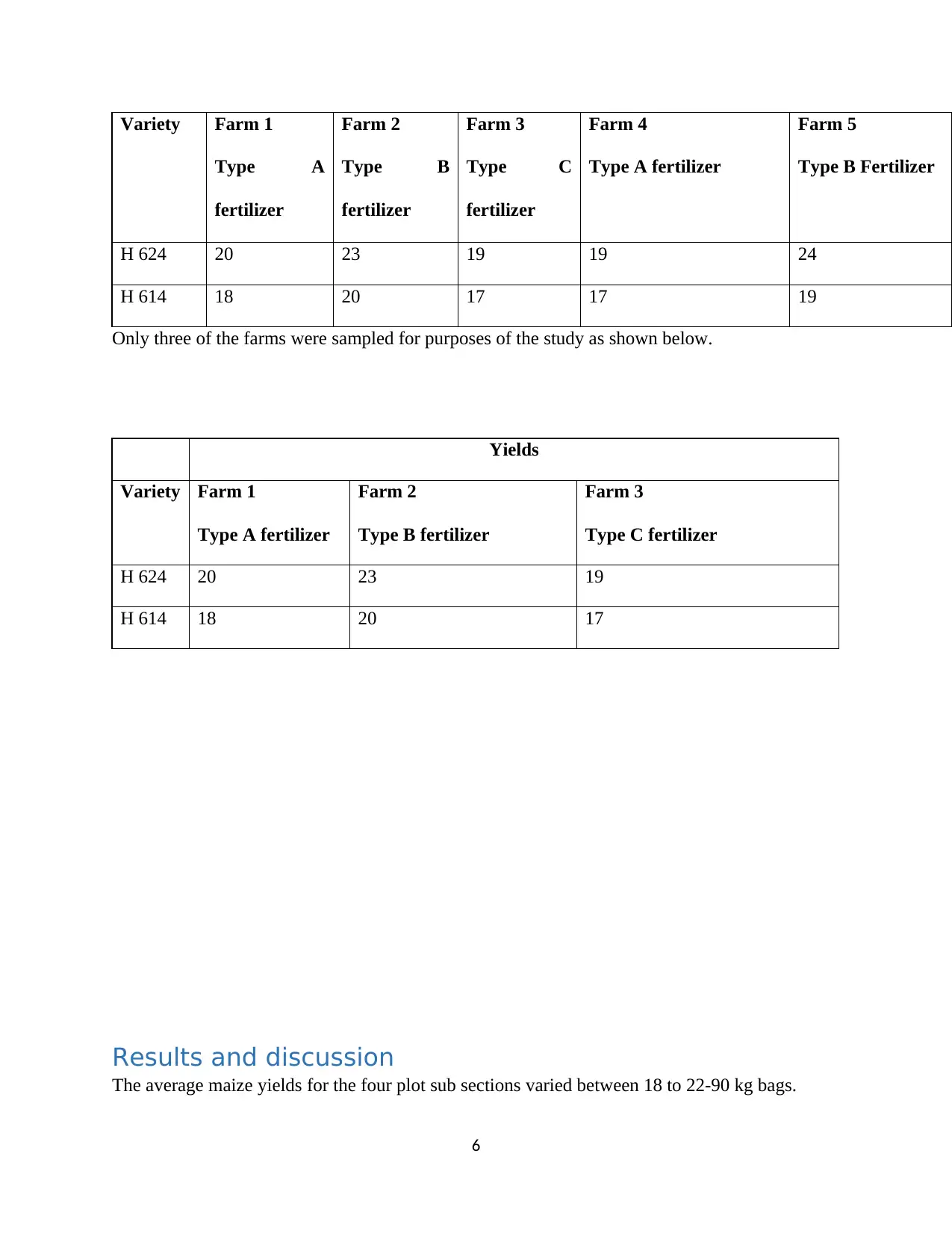
Type A
fertilizer
Farm 2
Type B
fertilizer
Farm 3
Type C
fertilizer
Farm 4
Type A fertilizer
Farm 5
Type B Fertilizer
H 624 20 23 19 19 24
H 614 18 20 17 17 19
Only three of the farms were sampled for purposes of the study as shown below.
Yields
Variety Farm 1
Type A fertilizer
Farm 2
Type B fertilizer
Farm 3
Type C fertilizer
H 624 20 23 19
H 614 18 20 17
Results and discussion
The average maize yields for the four plot sub sections varied between 18 to 22-90 kg bags.
6
Paraphrase This Document
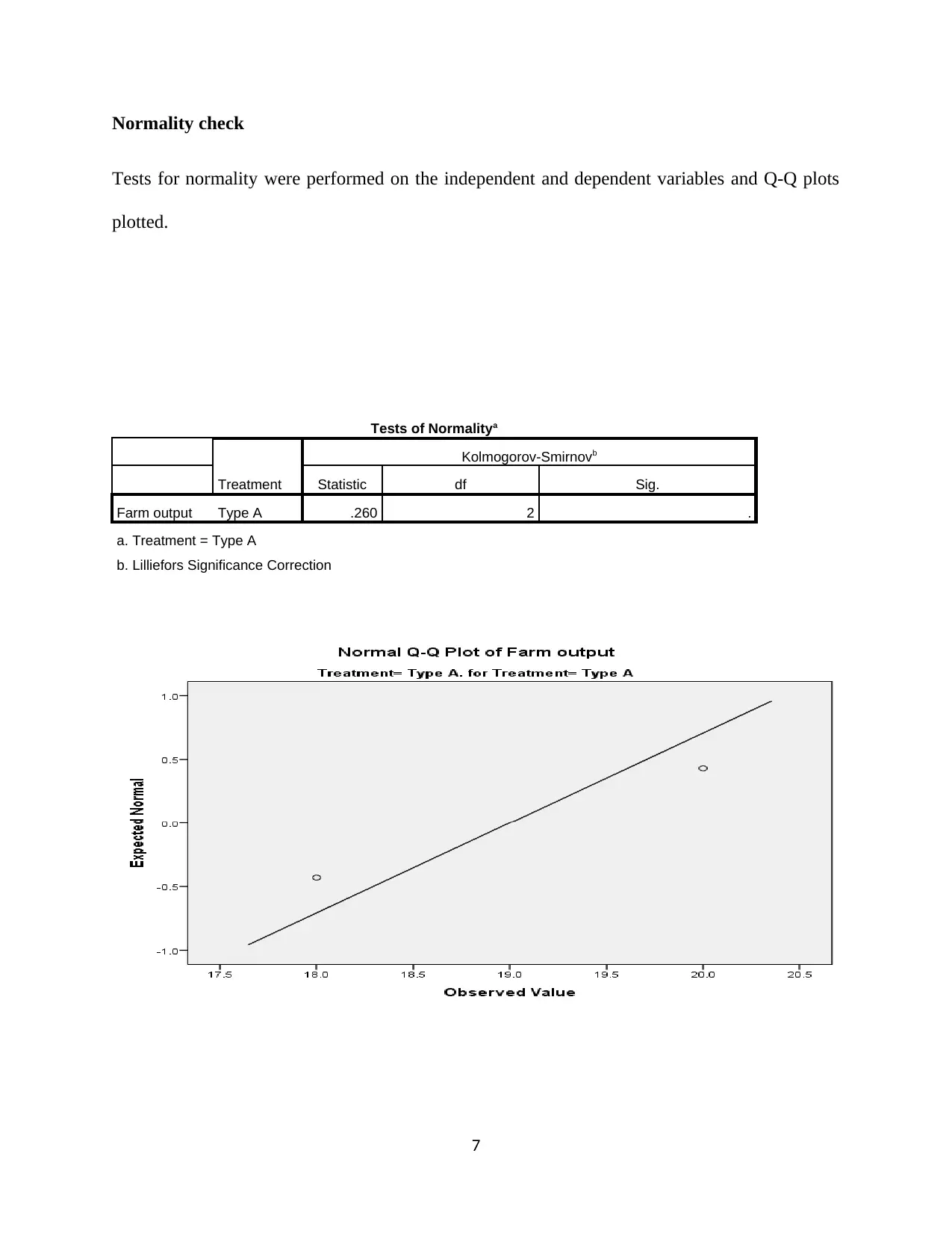
Tests for normality were performed on the independent and dependent variables and Q-Q plots
plotted.
Tests of Normalitya
Treatment
Kolmogorov-Smirnovb
Statistic df Sig.
Farm output Type A .260 2 .
a. Treatment = Type A
b. Lilliefors Significance Correction
7
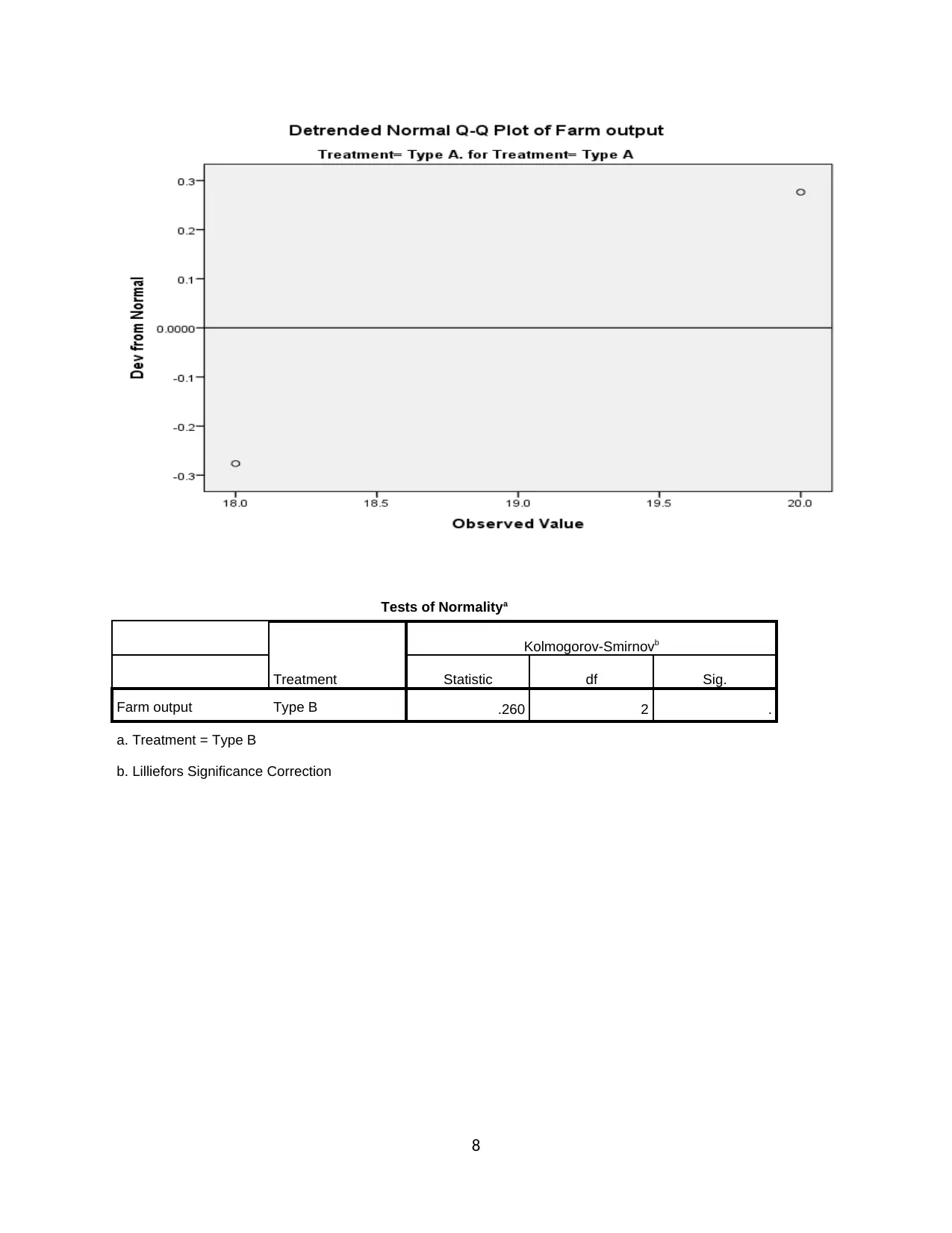
Treatment
Kolmogorov-Smirnovb
Statistic df Sig.
Farm output Type B .260 2 .
a. Treatment = Type B
b. Lilliefors Significance Correction
8
⊘ This is a preview!⊘
Do you want full access?
Subscribe today to unlock all pages.

Trusted by 1+ million students worldwide

Paraphrase This Document
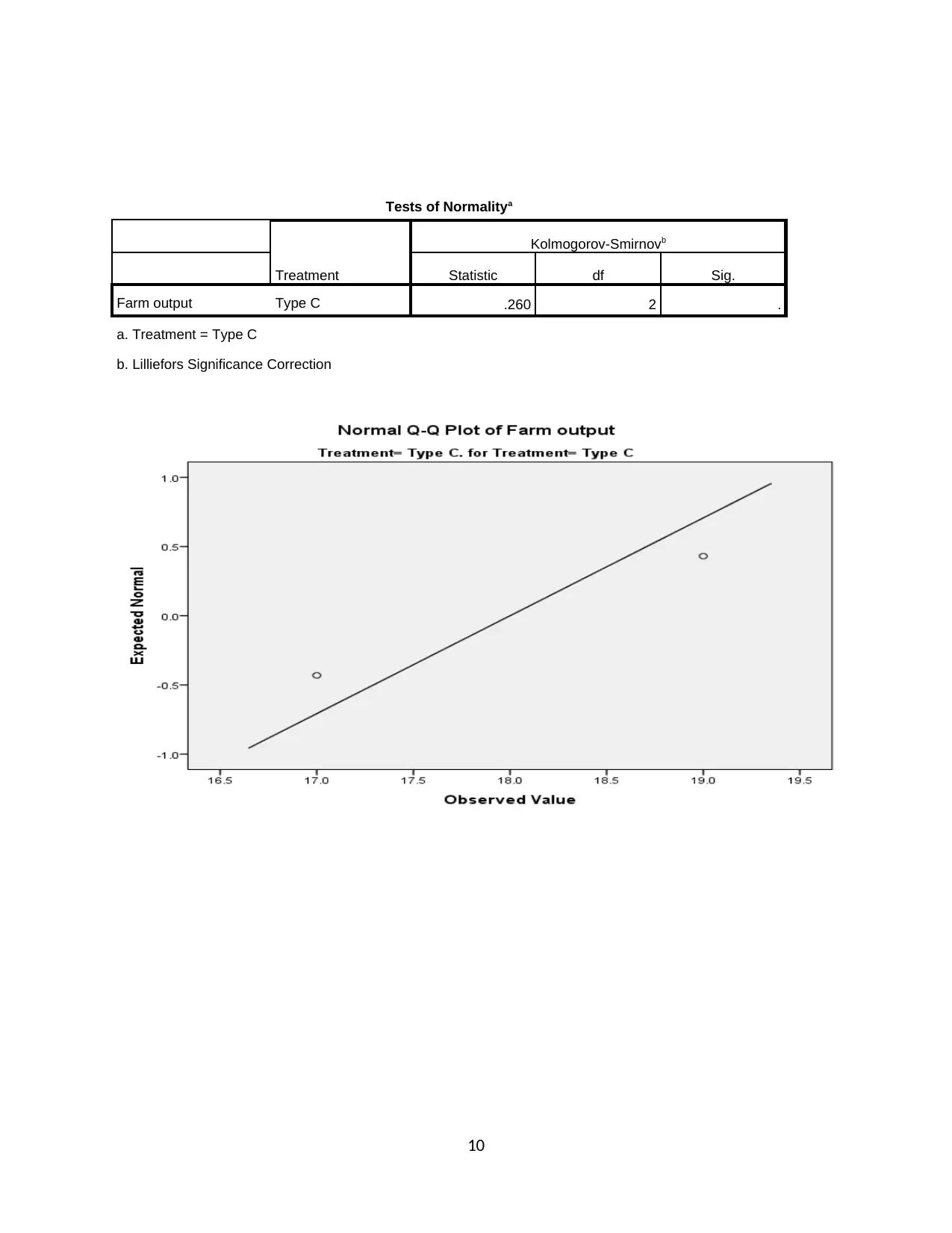
Treatment
Kolmogorov-Smirnovb
Statistic df Sig.
Farm output Type C .260 2 .
a. Treatment = Type C
b. Lilliefors Significance Correction
10

Univariate analysis
Treatment: Type A
Descriptivesa
Treatment Statistic Std. Error
Farm output Type A Mean 19.00 1.000
95% Confidence Interval for
Mean
Lower Bound 6.29
Upper Bound 31.71
5% Trimmed Mean .
Median 19.00
Variance 2.000
Std. Deviation 1.414
Minimum 18
Maximum 20
11
⊘ This is a preview!⊘
Do you want full access?
Subscribe today to unlock all pages.

Trusted by 1+ million students worldwide

Interquartile Range .
Skewness . .
Kurtosis . .
a. Treatment = Type A
Treatment: Type B
Descriptivesa
Treatment Statistic Std. Error
Farm output Type B Mean 21.50 1.500
95% Confidence Interval for
Mean
Lower Bound 2.44
Upper Bound 40.56
5% Trimmed Mean .
Median 21.50
Variance 4.500
Std. Deviation 2.121
Minimum 20
Maximum 23
Range 3
Interquartile Range .
Skewness . .
Kurtosis . .
a. Treatment = Type B
Treatment: Type C
Descriptivesa
Treatment Statistic Std. Error
Farm output Type C Mean 18.00 1.000
95% Confidence Interval for Lower Bound 5.29
12
Paraphrase This Document

5% Trimmed Mean .
Median 18.00
Variance 2.000
Std. Deviation 1.414
Minimum 17
Maximum 19
Range 2
Interquartile Range .
Skewness . .
Kurtosis . .
a. Treatment = Type C
Tests of Between-Subjects Effects
Between-Subjects Factors
N
Block H 614 3
H 624 3
Treatment Type A 2
Type B 2
Type C 2
Dependent Variable: Farm output
13
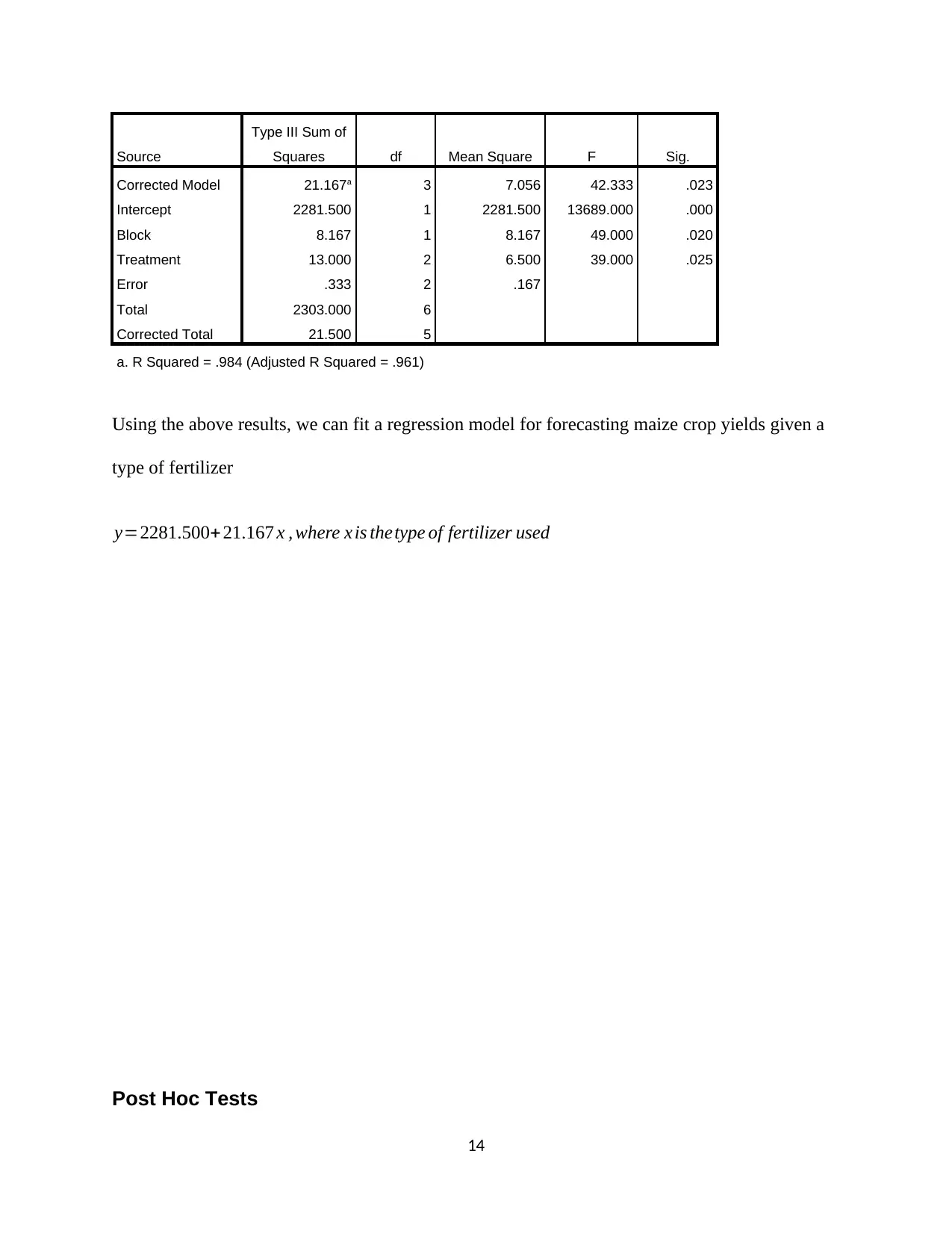
Type III Sum of
Squares df Mean Square F Sig.
Corrected Model 21.167a 3 7.056 42.333 .023
Intercept 2281.500 1 2281.500 13689.000 .000
Block 8.167 1 8.167 49.000 .020
Treatment 13.000 2 6.500 39.000 .025
Error .333 2 .167
Total 2303.000 6
Corrected Total 21.500 5
a. R Squared = .984 (Adjusted R Squared = .961)
Using the above results, we can fit a regression model for forecasting maize crop yields given a
type of fertilizer
y=2281.500+ 21.167 x , where x is thetype of fertilizer used
Post Hoc Tests
14
⊘ This is a preview!⊘
Do you want full access?
Subscribe today to unlock all pages.

Trusted by 1+ million students worldwide
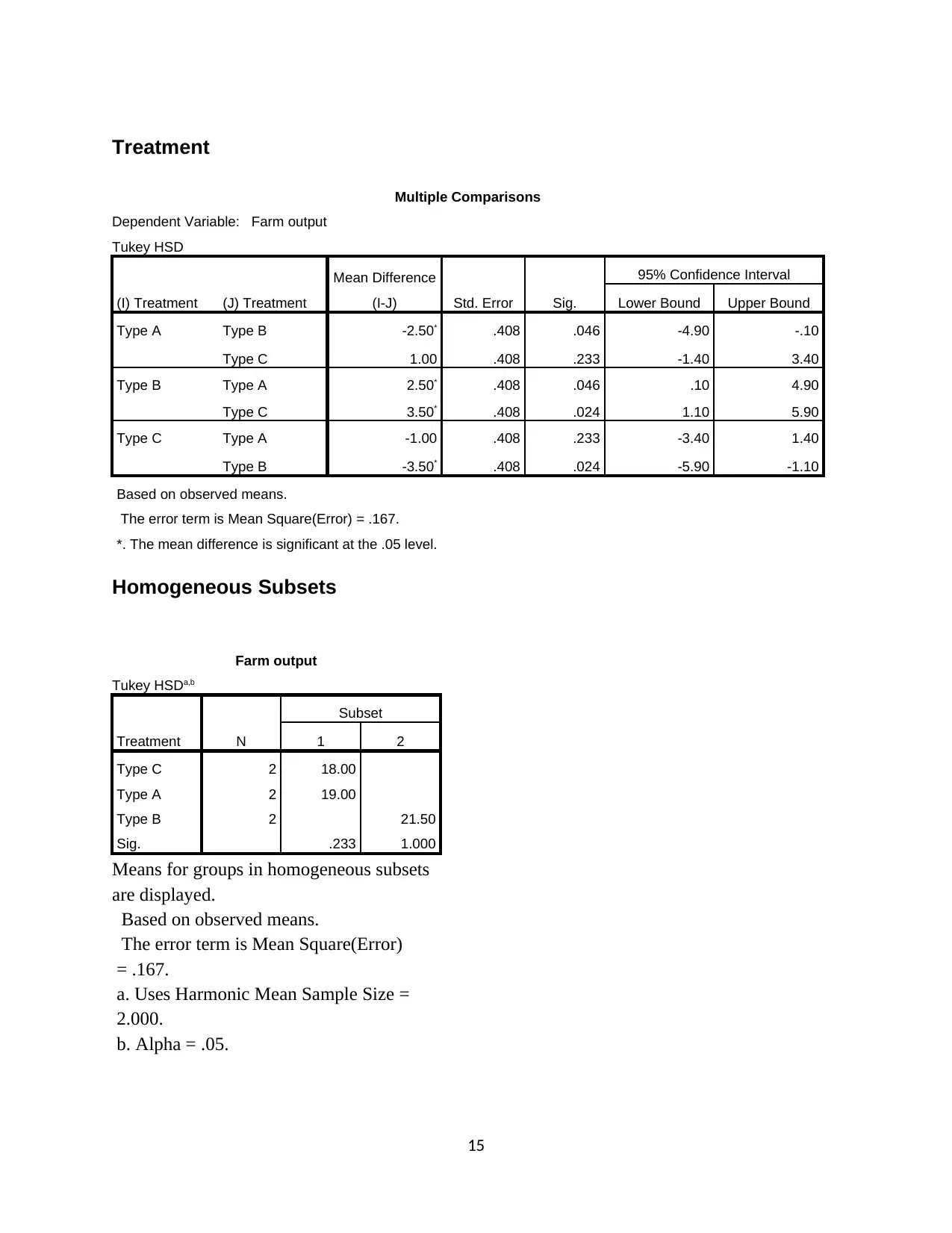
Multiple Comparisons
Dependent Variable: Farm output
Tukey HSD
(I) Treatment (J) Treatment
Mean Difference
(I-J) Std. Error Sig.
95% Confidence Interval
Lower Bound Upper Bound
Type A Type B -2.50* .408 .046 -4.90 -.10
Type C 1.00 .408 .233 -1.40 3.40
Type B Type A 2.50* .408 .046 .10 4.90
Type C 3.50* .408 .024 1.10 5.90
Type C Type A -1.00 .408 .233 -3.40 1.40
Type B -3.50* .408 .024 -5.90 -1.10
Based on observed means.
The error term is Mean Square(Error) = .167.
*. The mean difference is significant at the .05 level.
Homogeneous Subsets
Farm output
Tukey HSDa,b
Treatment N
Subset
1 2
Type C 2 18.00
Type A 2 19.00
Type B 2 21.50
Sig. .233 1.000
Means for groups in homogeneous subsets
are displayed.
Based on observed means.
The error term is Mean Square(Error)
= .167.
a. Uses Harmonic Mean Sample Size =
2.000.
b. Alpha = .05.
15
Paraphrase This Document
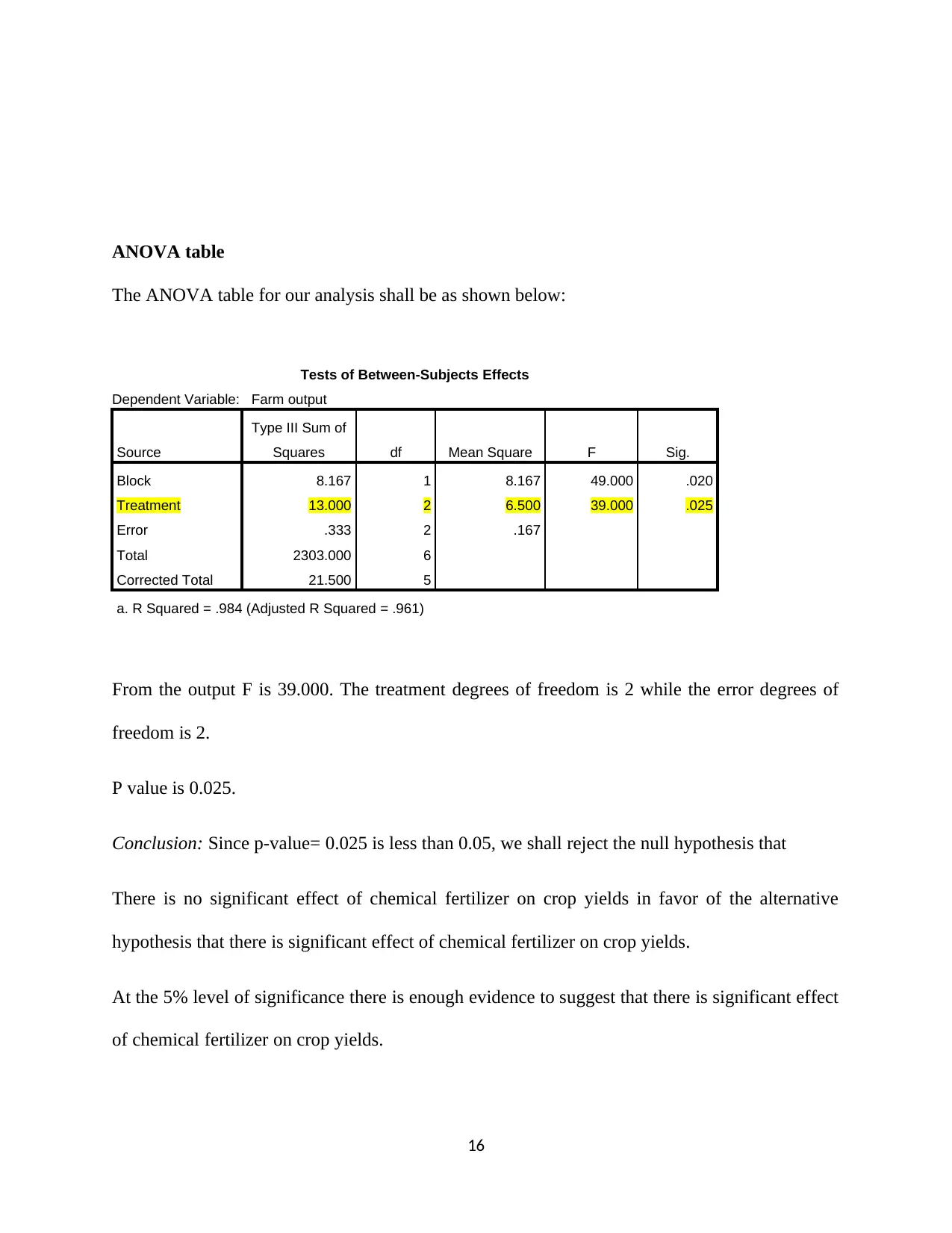
The ANOVA table for our analysis shall be as shown below:
Tests of Between-Subjects Effects
Dependent Variable: Farm output
Source
Type III Sum of
Squares df Mean Square F Sig.
Block 8.167 1 8.167 49.000 .020
Treatment 13.000 2 6.500 39.000 .025
Error .333 2 .167
Total 2303.000 6
Corrected Total 21.500 5
a. R Squared = .984 (Adjusted R Squared = .961)
From the output F is 39.000. The treatment degrees of freedom is 2 while the error degrees of
freedom is 2.
P value is 0.025.
Conclusion: Since p-value= 0.025 is less than 0.05, we shall reject the null hypothesis that
There is no significant effect of chemical fertilizer on crop yields in favor of the alternative
hypothesis that there is significant effect of chemical fertilizer on crop yields.
At the 5% level of significance there is enough evidence to suggest that there is significant effect
of chemical fertilizer on crop yields.
16
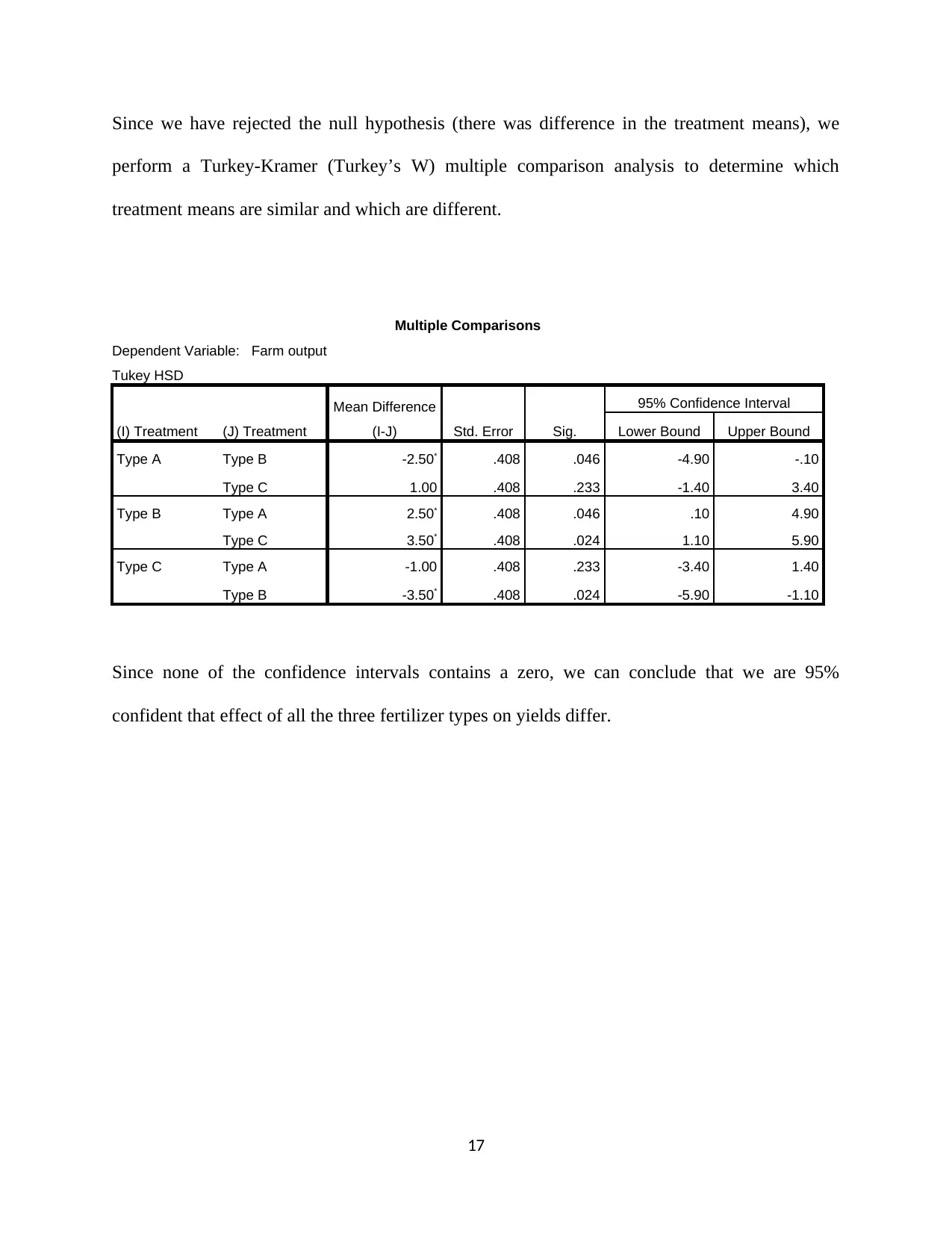
perform a Turkey-Kramer (Turkey’s W) multiple comparison analysis to determine which
treatment means are similar and which are different.
Multiple Comparisons
Dependent Variable: Farm output
Tukey HSD
(I) Treatment (J) Treatment
Mean Difference
(I-J) Std. Error Sig.
95% Confidence Interval
Lower Bound Upper Bound
Type A Type B -2.50* .408 .046 -4.90 -.10
Type C 1.00 .408 .233 -1.40 3.40
Type B Type A 2.50* .408 .046 .10 4.90
Type C 3.50* .408 .024 1.10 5.90
Type C Type A -1.00 .408 .233 -3.40 1.40
Type B -3.50* .408 .024 -5.90 -1.10
Since none of the confidence intervals contains a zero, we can conclude that we are 95%
confident that effect of all the three fertilizer types on yields differ.
17
⊘ This is a preview!⊘
Do you want full access?
Subscribe today to unlock all pages.

Trusted by 1+ million students worldwide

Conclusion
From the findings of the research and analysis, conducted it has been shown that indeed chemical
fertilizers have a significant effect on crop yields. Different types of fertilizers lead to different
volumes of crop yield.
However, different types of fertilizers could respond differently based on location of the farms.
Areas with insufficient rainfall or irrigation water could respond poorly to a type of fertilizer that
responds well to crops grown in areas with sufficient rainfall or irrigation water.
Recommendations
Based on the study findings and conclusion, farmers should choose the right type of fertilizer to
use on their farms for maximum crop production.
18
Paraphrase This Document
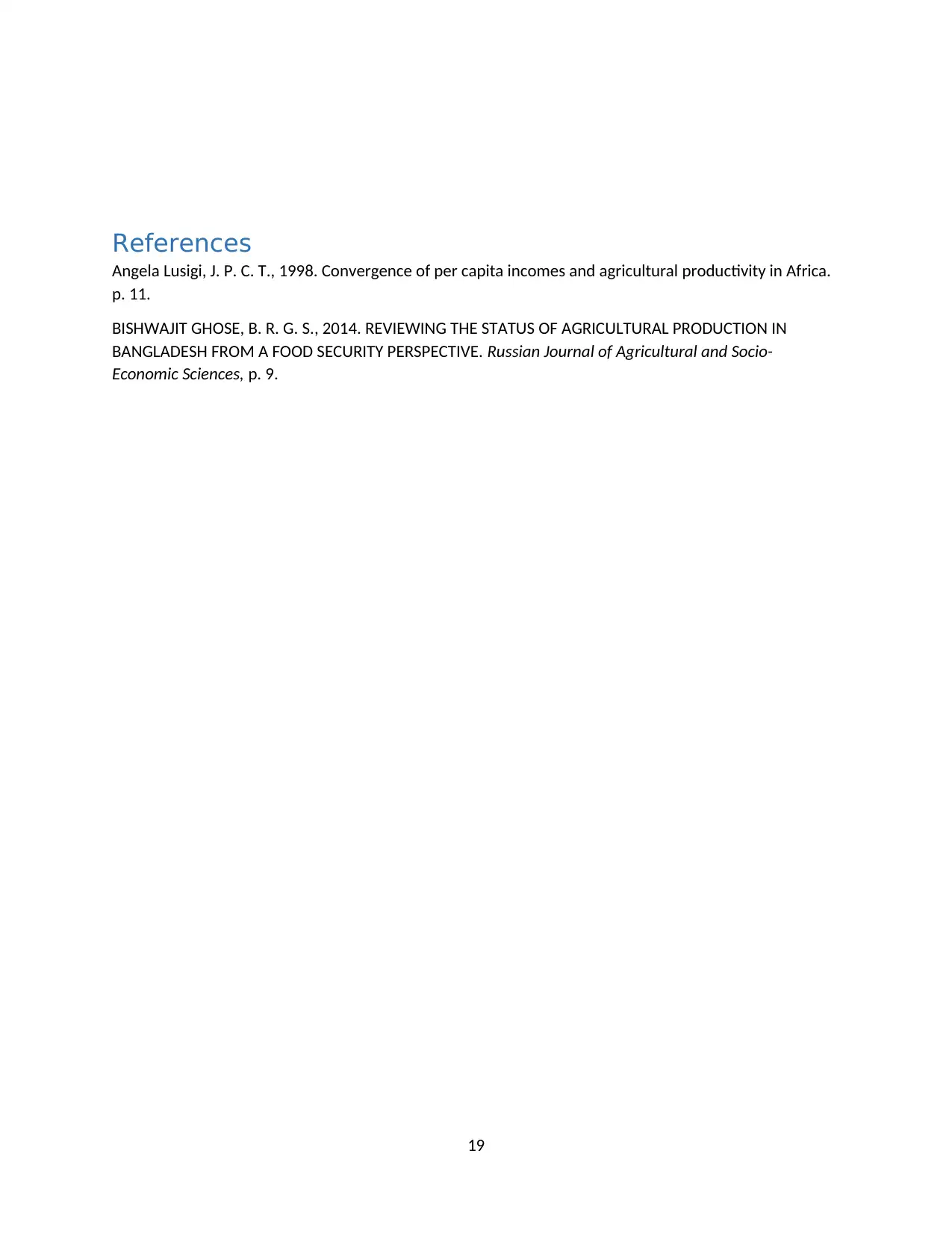
Angela Lusigi, J. P. C. T., 1998. Convergence of per capita incomes and agricultural productivity in Africa.
p. 11.
BISHWAJIT GHOSE, B. R. G. S., 2014. REVIEWING THE STATUS OF AGRICULTURAL PRODUCTION IN
BANGLADESH FROM A FOOD SECURITY PERSPECTIVE. Russian Journal of Agricultural and Socio-
Economic Sciences, p. 9.
19

⊘ This is a preview!⊘
Do you want full access?
Subscribe today to unlock all pages.

Trusted by 1+ million students worldwide
Your All-in-One AI-Powered Toolkit for Academic Success.
+13062052269
info@desklib.com
Available 24*7 on WhatsApp / Email
![[object Object]](/_next/static/media/star-bottom.7253800d.svg)
© 2024 | Zucol Services PVT LTD | All rights reserved.